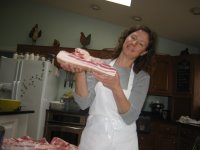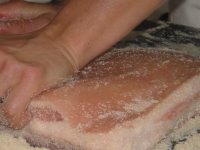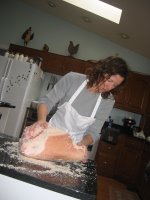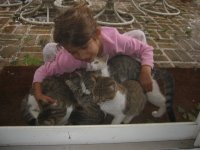That's a line from a comment I read at
Sheep Woman's Blog today, which seems particularly poignant as we just put a deposit down on three ewe Navajo-Churro lambs on Wednesday. One of the questions I asked Linda, the woman from whom we're buying these three lovelies, is whether she ever ate her lambs. Her response: "We always have a lamb in the freezer."
I've wanted sheep ever since I can remember—I love the aesthetic quality of a flock on a hillside. Jim loves lamb. Something in it for both of us. Plus, I'm dying to try to make cheese—not just goat cheese, but sheep's milk cheese, and cow's milk cheese, and lots of it. A milking cow will probably be our next specie addition to the farm, but not for another year or so. Off we go on another adventure!

This is Faith, a bottle-raised ewe lamb who's the smallest of quads. She's as sweet as can be, and the kiddos fell in love with her at once. How could I say no? Both she and Candace, below, have black tongues, which is one indicator whether they may throw colored lambs.

To the right is Esther, who has lovely gray wool and beautiful coloring, though Linda assures me they will lose it after second shearing or so. Apparently, Navajo-Churro sheep will keep their wool color, face color, and leg color, but the hair color gradually fades and blends.

Meet Candace, the black sheep that Jim and I both really wanted. She may or may not come home with us, as someone else had expressed an interest in her—though without a deposit or a scheduled visit. We went ahead and put a deposit on her with the understanding that it may be applied to our balance if she goes to the other home. We'll be sad to lose her, of course, but considering we only went up for two lambs, I shouldn't be too greedy. I've relinquished Candace's fate to the universe—if it's meant to be, she'll come home with us in June when the babies will be ready to leave their mamas. (*Update: I just got word that Candace is our little black sheep. Yay!)
Lambs may, indeed, be the most difficult animal we raise for food, though I've found that raising our own meat nourishes more than just the body. There's a deep wisdom hidden in the words, "How can you eat something you don't know?" I've discovered a relationship between farmer and livestock that's hard to describe, but it's primal, basic, rudimentary, and real, I'd say if pressed to describe it. Hauling water to our pigs every day for four months, looking them in the eye every day, getting to know them, generates that same feeling of accomplishment found in having earth under my nails or building with my hands. Of course, I didn't grow the pig; the pig grew itself. But I played no small part in the process, and, in the end, I took karmic responsibility for the bounty on my table.
 We enjoyed a delicious country breakfast the other morning with fresh fried eggs, our own pork sausage (mmmmm!), cheese grits, and...well...bagels imported from New Jersey with the grandparents, but they're soooo good!
We enjoyed a delicious country breakfast the other morning with fresh fried eggs, our own pork sausage (mmmmm!), cheese grits, and...well...bagels imported from New Jersey with the grandparents, but they're soooo good!  We had some of our bacon the day it finished curing. Wooooeeee, was it salty! We soaked it for about 4 hours that afternoon in some ice water, which improved the flavor tremendously. It's still salty, but more in line with prosciutto or belly lox, both of which I love. Thank goodness, because I was pretty bummed worrying that I'd ruined nearly 40lbs of bacon! Jim says the upside of it being salty is that we eat less of it in one sitting, and I can see the point.
We had some of our bacon the day it finished curing. Wooooeeee, was it salty! We soaked it for about 4 hours that afternoon in some ice water, which improved the flavor tremendously. It's still salty, but more in line with prosciutto or belly lox, both of which I love. Thank goodness, because I was pretty bummed worrying that I'd ruined nearly 40lbs of bacon! Jim says the upside of it being salty is that we eat less of it in one sitting, and I can see the point.  After soaking it, I patted it dry and vacuum sealed each cut. They averaged out to 4lb packages each or thereabouts. I'm still going back and forth on whether I will try to dry hang the hams or freeze those as well. The whole cure equalization and hanging part seems ridiculously complex, according to the Virginia extension instructions I found. The temps and conditions seem rather difficult to achieve, especially in our larder in our basement, which keeps a pretty constant coolish temp throughout the year. Since the cure takes about 40 days, I still have plenty of time to decide.
After soaking it, I patted it dry and vacuum sealed each cut. They averaged out to 4lb packages each or thereabouts. I'm still going back and forth on whether I will try to dry hang the hams or freeze those as well. The whole cure equalization and hanging part seems ridiculously complex, according to the Virginia extension instructions I found. The temps and conditions seem rather difficult to achieve, especially in our larder in our basement, which keeps a pretty constant coolish temp throughout the year. Since the cure takes about 40 days, I still have plenty of time to decide.






















